Diamond Clarity Guide
What Is Diamond Clarity?
The clarity of a diamond is essentially a measure of its purity. Because the value of a commodity is determined by its quality and not purely by its size, clarity is a much sought-after and precious measure when it comes to finding the stone that will be with you for a lifetime.
When it comes to clarity, imperfections and inclusions are what truly matter. Diamonds are created out of carbon atoms that are subject to intense pressure and temperature, deep inside the earth, over the course of millions of years. Their unique sparkle and brilliance results from a particular arrangement of the carbon atoms, and any departure from that arrangement, results in reduced clarity or purity of the overall stone.
The standard way inclusions are measured by an expert using a 10x magnification eyepiece. By standardising how inclusions are assessed, the diamond community has created a highly objective measure to check the quality and purity of any given precious stone.
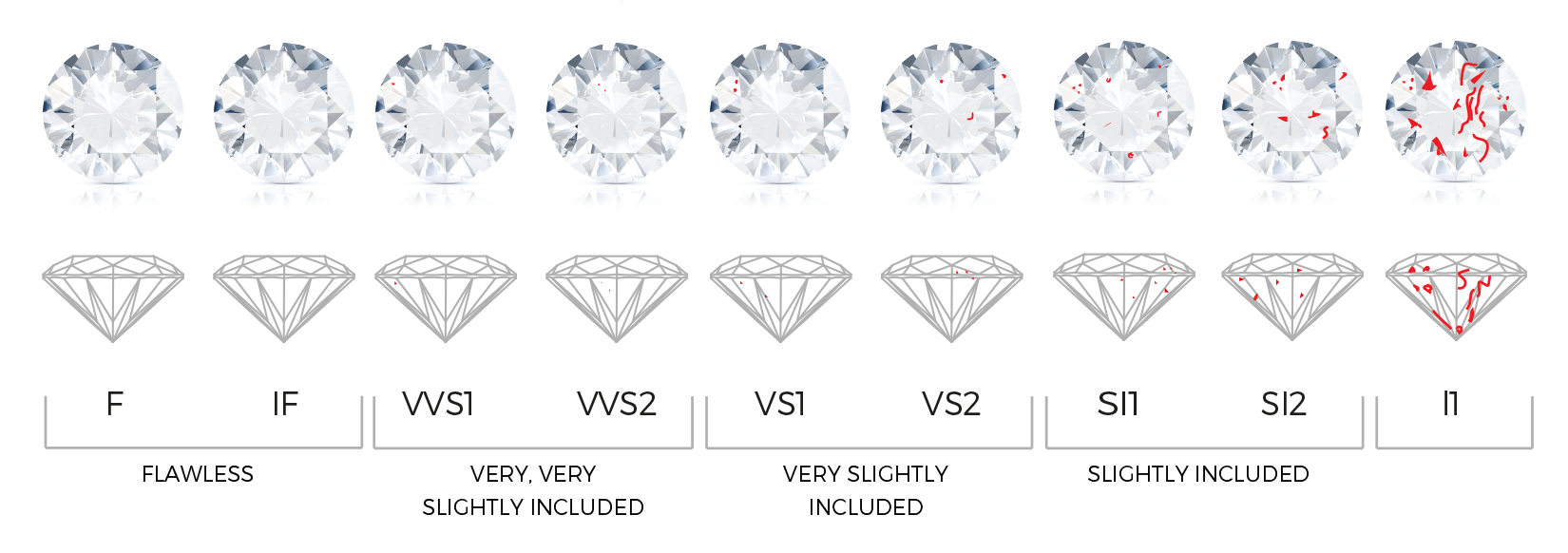
The Grading System
You have seen a quick breakdown of the scale and how it works on the homepage, but what does it mean in practice? Let’s take a look at what it means.
Popularity: VS1-VS2 is the most popular grade of clarity in the diamond world. They appear flawless to the naked eye and only come in at a small fraction of a genuinely excellent diamond price. This makes them the perfect balance between aesthetics and cost.
Value: For the shopper on a budget, the SI1 range is by far the most popular. This clarity grade has minimal inclusions visible to the naked eye, allowing for a stone that retains its natural beauty with minimal degradation.
Cut Choices: It’s essential to know that brilliant-cut diamonds do better at suppressing the negative aesthetics of inclusions than step-cuts. This can allow you to come down one or two clarity grades without sacrificing the overall look and brilliance of the stone.
Diamond Clarity Grading
Clarity IF
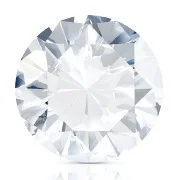
Internally flawless
Diamonds in this grade have no visible flaws even when examined at x10 magnification.
Clarity VVS1
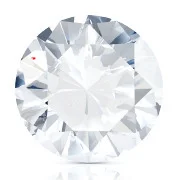
Very, very slight inclusion.
Diamonds with a VVS1 or VVS2 grade have barely any inclusions and these can only be found under very high magnification.
Clarity VVS2
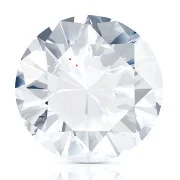
Very, very slight inclusion.
Diamonds with a VVS1 or VVS2 grade have barely any inclusions and these can only be found under very high magnification.
Clarity VS1
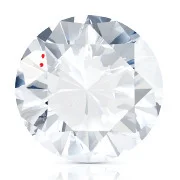
Very slight inclusion.
VS1 diamonds have a series of tiny inclusions that in common with the VS1 grade can only be discovered using x10 magnification.
Clarity VS2
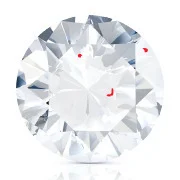
Very slight inclusion.
VS2 diamonds have a series of tiny inclusions that in common with the VS2 grade can only be discovered using x10 magnification.
Clarity SI1
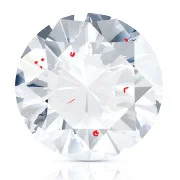
Slight inclusion.
Slight inclusions are easily found under x10 magnification. SI1 graded diamonds have small inclusions that will be visible to the naked eye.
Clarity SI2
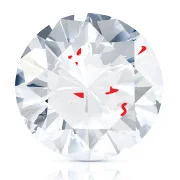
Slight inclusion.
Diamonds have a greater number of inclusions that will almost always be visible to the naked eye. In comparison to I1 clarity they are more sparkling due to less number of inclusion.
Clarity I1

Inclusion.
Diamonds have numerous inclusions that can easily be seen. Diamonds of this clarity represent incredible value compared with higher clarity grades. These diamonds are perfect for people not sensitive to the presence of inclusions, but want a larger size (or weight) of diamond.
What Types Of Inclusions Are There?
The last thing we would like to look at is the specifics of the different types of inclusions. They are:
Laser Drill Holes: To bleach darker inclusions, a tiny hole is drilled into the stone and acid is used to recolour the diamond.
Beaded Girdle: This is where tiny feathers are positioned around the edges of the stone, extending from the girdle.
Knot: A foreign body near the surface can result in a rough texture.
Indented Natural: A part of the original rough diamond that remains on the surface, causing a minor indentation.
Cavity: A larger dent or opening in the stone.
Chip: A small surface opening, sometimes caused by poor craftsmanship during the cutting process.
Chipped Culet: A small visible spot, which is usually man made.
Cloud: Large cluster of inclusions.
Included Crystal: A stone within a stone.
Pinpoints: Tiny black or white crystals that are included in the diamond; they can occur individually or in larger groups.
Feathers: They are of various types, and all look like minor fractures, like cracked ice or glass.
FAQs
Abelini uses a range of diamond clarities, but they mention that VS1-VS2 are the most popular due to their balance between aesthetics and cost. For budget shoppers, they recommend the SI1 range due to its value and minimal visible inclusions.
Clarity refers to the presence of inclusions or blemishes within a diamond that can affect its sparkle and brilliance. Colour, on the other hand, refers to the presence of any color in a diamond, with the most valuable diamonds being completely colorless.
Clarity refers to the internal and external imperfections of a diamond, whereas the cut refers to how a diamond has been cut from its raw form. The quality of a diamond's cut can influence its brilliance and sparkle.
According to Abelini, the SI1 clarity grade offers the best value. Diamonds of this grade have minimal inclusions visible to the naked eye, allowing for a stone that retains its natural beauty with minimal degradation.
Diamond inclusions are formed when there are departures from the ideal arrangement of carbon atoms in a diamond. This can occur due to intense pressure and temperature deep inside the Earth over millions of years. Inclusions can take various forms, such as laser drill holes, beaded girdle, knot, indented natural, cavity, chip, chipped culet, cloud, included crystal, pinpoints, and feathers.
Inclusions in diamonds graded SI1 and lower can be visible to the naked eye, whereas inclusions in diamonds graded VS2 and higher are not visible without magnification.
The lowest quality diamond in terms of clarity is the I1 grade. Diamonds of this grade have numerous inclusions that can easily be seen. However, they represent incredible value compared with higher clarity grades.
The diamond clarity grading from best to worst is as follows: IF (Internally Flawless), VVS1 (Very, Very Slight Inclusion 1), VVS2 (Very, Very Slight Inclusion 2), VS1 (Very Slight Inclusion 1), VS2 (Very Slight Inclusion 2), SI1 (Slight Inclusion 1), SI2 (Slight Inclusion 2), and I1 (Inclusion 1).
Both VS2 and VS1 diamonds have inclusions that are not visible to the naked eye. The choice between VS2 and VS1 may depend on factors like your budget and personal preferences.
Certain diamond cuts are better at hiding inclusions than others. For example, round brilliant cuts are often better at hiding inclusions than step cuts.
While SI1 clarity grade is technically one below VS2, it really depends on how the diamond is used.